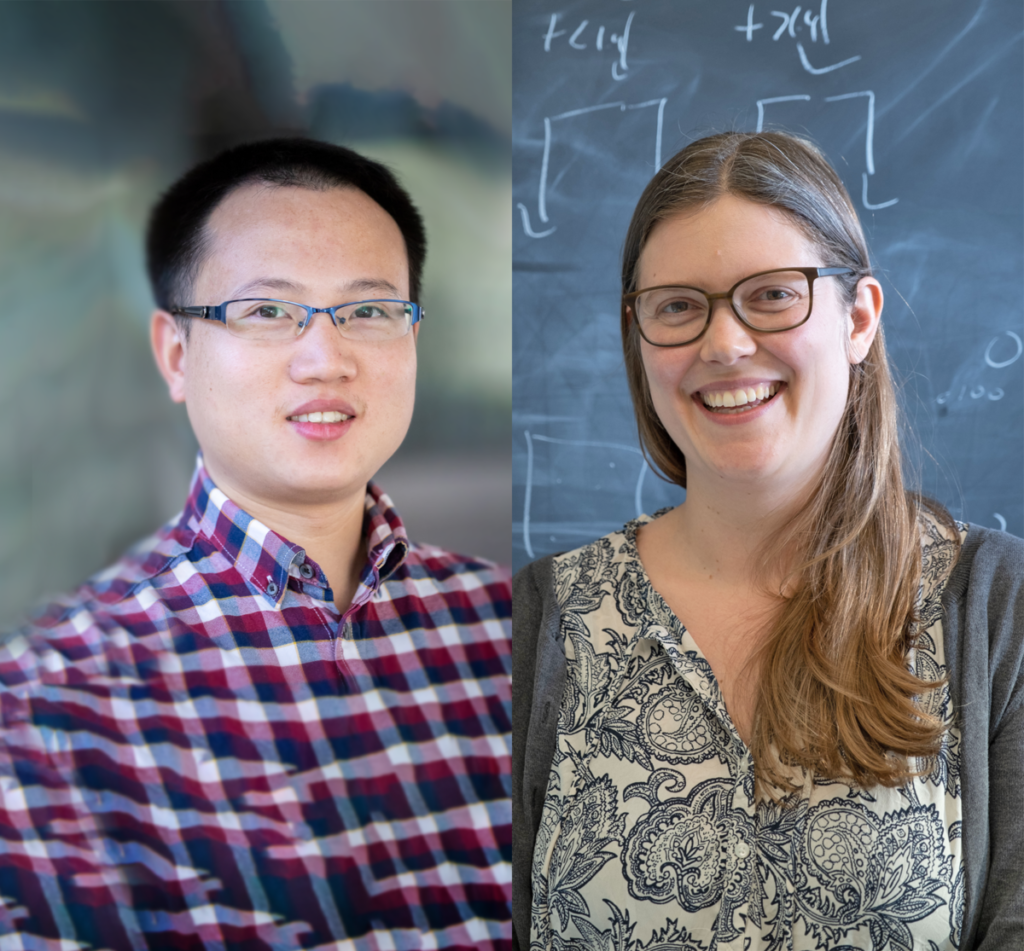Wu/Schoop/Cava reveal new quantum state in novel material
In an experiment related to the theory of Luttinger Liquids (LLs), a team led by Princeton University physicists and chemists reports the realization of a one-dimensional linear array of LLs in a moiré superlattice – a new quantum state in an engineered structure made from a known material.
The material behind their discovery is twisted bilayer tungsten ditelluride (tWTe2). It displayed this exotic behavior when the angle between two stacked monolayers was twisted by about five degrees.
The electrons in the material, which act freely in the thick bulk crystals, were strongly correlated when confined to the atomically thin twisted bilayers, forming perfect arrays of linear conducting channels in two dimensions.
This behavior was not expected in typical, two-dimensional systems.

Sanfeng Wu, assistant professor in the Department of Physics; and Leslie Schoop, assistant professor in the Department of Chemistry.
The research, “One-Dimensional Luttinger Liquids in a Two-Dimensional Moiré Lattice,” was reported this week in Nature.
The theory of Luttinger Liquids predicts how electrons move and behave in a one-dimensional system. There are ideas on how electrons, in extremely rare situations, could behave like an LL in a two-dimensional metal, but no experimental observations until now.
Sanfeng Wu, an assistant professor in the Department of Physics, is P.I. on the research. Department of Chemistry Assistant Professor Leslie Schoop and Russell Wellman Moore Professor of Chemistry Robert Cava and their labs contributed to the collaboration.
This result was a “purely experimental surprise,” said Wu. The research was originally designed to observe whether the twist angle would alter the novel types of quantum phenomena in WTe2.
“What we find is that the electrons in this two-dimensional moiré that we twist, when you lower the temperatures cooling down the material, they suddenly become an array of 1D conductors. This is very exotic,” said Wu. “Any idea that proposed to achieve the Luttinger Liquid physics in a 2D system was believed to be very challenging to realize. It’s the first time we’ve done this using tWTe2.”
“We are just starting to touch the physics coming out of this completely new quantum system. It’s very exciting. We are asking a lot of questions about the quantum physics that can be experimentally tested now that were not possible previously.”
Schoop said the research reflects the expertise of several labs working under one investigation.
“Sanfeng does really beautiful experiments nobody else can do. He sets up these beautiful devices where he discovers new physics from crystals that I provide that I haven’t seen anyone else doing.
“It’s very logical if you look at the crystal structure and the lattice that if you twist this, then you get these chains,” Schoop said. “It’s very easy to understand, very intuitive. I don’t want to say it’s simple, because it was a lot of work. But the story is simple. And I think this is always beautiful in science when something appears simple.”

Robert Cava, the Russell Wellman Moore Professor of Chemistry; and Ratnadwip Singha, postdoctoral research associate with the Schoop Lab.
Ratnadwip Singha, a postdoc with the Schoop Lab, called the discovery “thrilling.”
“One of the reasons is that we were always told that in the monolayer, maybe we can get some interesting band structure in this material,” Singha said. “But to create this moiré pattern and get this new quantum state is a completely new aspect of this material.”
Wu has worked with the Schoop Lab and the Cava Lab on several previous projects. He especially credited the chemists with creating superlative pure crystals of WTe2—and lots of them. Defects in crystals can impact both the experimental results and their interpretation. The purer the bulk crystal, the fewer the defects. The purity of the samples enabled Wu to exfoliate single layers of high-quality crystal from the bulk material, an expertise for which the Wu Lab is known.
“It really is gratifying to see that if you put a lot of effort into growing the crystals at the highest purity, then it helps scientists like Sanfeng do their best work,” said Schoop. “It really has an impact. As a crystal grower, I have a desire to make them perfect. And this is really proof that it matters.
The research behind the discovery has a history at Princeton.
In 2014, bulk crystals of tungsten ditelluride, grown in Cava’s lab and studied in the lab of Eugene Higgins Professor of Physics N. Phuan Ong, enabled the unusual properties of this material to be discovered. Hailed as a huge success at the time and published in Nature, that investigation led to a raft of experiments with the new material.
That same year at Princeton, Professor of Physics B. Andrei Bernevig used theoretical insights to predict topological properties for tungsten ditelluride.
Wu started work on the two-dimensional versions of this material at about that time and developed a number of experimental techniques for creating and investigating them. The team worked closely together, making a series of discoveries prior to this research.
“It is fulfilling to see that you can contribute to this kind of project where you realize you are really pushing the boundary and opening up a new direction that people can study and create new phases of matter,” said Singha. “We are confident this idea will lead to many more works and yield new physics in this system.”
Read the full paper in Nature here: https://www.nature.com/articles/s41586-022-04514-6
Research for “One-Dimensional Luttinger Liquids in a Two-Dimensional Moiré Lattice” was supported by the National Science Foundation through a CAREER award (DMR-1942942) and the Princeton University Materials Research Science and Engineering Center (DMR-2011750). In addition, the authors acknowledge support from the Eric and Wendy Schmidt Transformative Technology Fund at Princeton.
